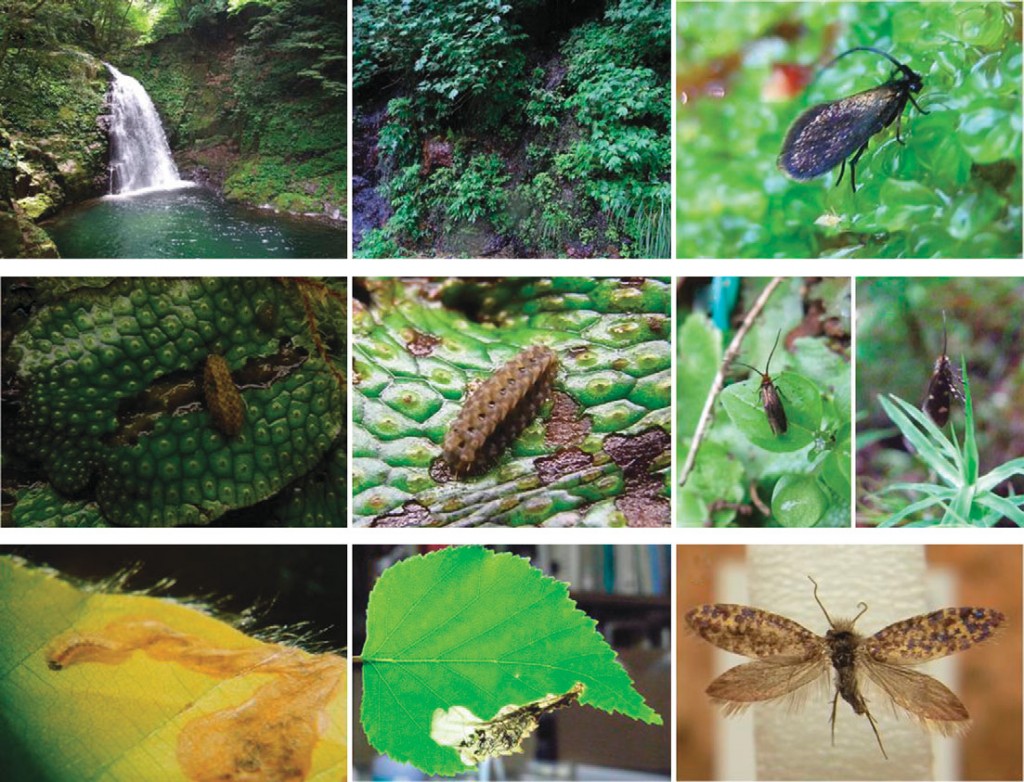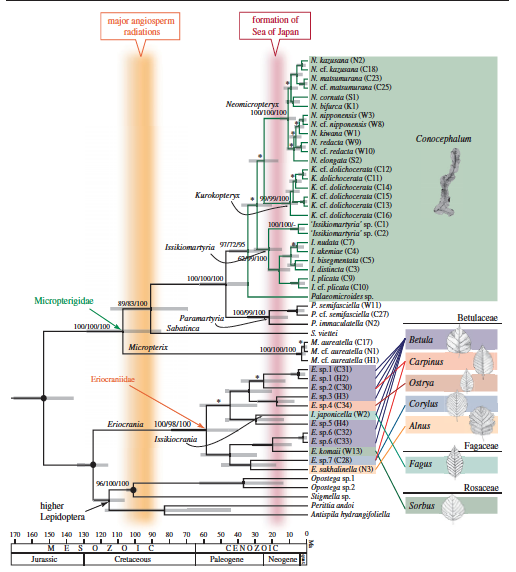![]() Každý, kdo je pravděpodobně obeznámený s standardním modelu pro můra nebo motýl – a sláma-jako nos, jak dosáhnout nektar skryté uvnitř květů. The vast majority of the Lepidoptera have diversified alongside the radiation of angiosperm plants, se stal jedním z nejvíce různorodých a hojný objednání života na Zemi. This paradigm however does not apply to the Micropterigidae, které představují nejen nejvíce bazální počet řádků Lepidoptera, ale jsou jedním ze tří rodin, které si zachovaly kusadla pro broušení pylu nebo výtrusů a spoléhají se na mechorostů, tlející organické hmoty nebo houby jako larvy hostitele. Prior assumptions as to the diversity of this group were based on the vast age of the lineage (110 milionů let) a nahromadění starých rodů. A Nedávná studie o japonských druhů of Micropterigidae by Yume Imada and her colleagues at Kyoto University provides evidence to the contrary and applies molecular techniques to test the hypothesis of allopatric speciation without niche shift.
Každý, kdo je pravděpodobně obeznámený s standardním modelu pro můra nebo motýl – a sláma-jako nos, jak dosáhnout nektar skryté uvnitř květů. The vast majority of the Lepidoptera have diversified alongside the radiation of angiosperm plants, se stal jedním z nejvíce různorodých a hojný objednání života na Zemi. This paradigm however does not apply to the Micropterigidae, které představují nejen nejvíce bazální počet řádků Lepidoptera, ale jsou jedním ze tří rodin, které si zachovaly kusadla pro broušení pylu nebo výtrusů a spoléhají se na mechorostů, tlející organické hmoty nebo houby jako larvy hostitele. Prior assumptions as to the diversity of this group were based on the vast age of the lineage (110 milionů let) a nahromadění starých rodů. A Nedávná studie o japonských druhů of Micropterigidae by Yume Imada and her colleagues at Kyoto University provides evidence to the contrary and applies molecular techniques to test the hypothesis of allopatric speciation without niche shift.
Autoři cestoval do 46 localities across the Japanese archipelago and collected all 16 známé endemický druh, několik nových druhů, a dost možná nový rod. Finding these moths in the wild is not all that difficult if you know how to find the habitat and how not to fall off slippery rocks; ale jakmile se vám najít místo můry mohou být bohatý. Micropterigidae are unsurprisingly associated with their bryophytes, které se vyskytují ve vlhkých biotopech podél potoků a řek. The very nature of a minute and slow moving animal in isolated pockets lends itself to allopatric speciation. Many microlepidoptera barely fly off of their host plant and even when they do they are not known for long distance dispersal. While the majority of genera and species are completely isolated across Japan there are a few instances where the genus Paramartyria occurs within populations of Issikiomartyria. While it is unknown precisely how these species might partition their host resources it is very likely to be a temporal difference in life-cycles. Here in California there is a vastly confusing complex of Apodemia butterflies that comprise a handful of species and (samozřejmě) poddruh, které jsou rozdělené na stejné rostlině období jaře a na podzim chovu.
Působivě, every micropterigid collected as larvae were found only on the Conocephalum conicum druh jaterník, Navzdory tam a to až do čtrnácti dalších mechorostů k dispozici ve stejném prostředí. It had been long understood that the Asian Micropterigidae fed on liverworts, ale rozsah jejich specifičnosti hostitele nikdy nebyly kvantifikovány. Feeding behavior appears to be the same across all of the surveyed species, s housenkami pastvu podél horní části mechorostů konzumovat horní vrstvy tkáně.
Fylogenetická analýza ČOI, 18S a EF-1α geny vygenerována velmi shodné stromy používající více analytických metod. It appears that the endemic Japanese genera and the Conocephalum krmení strategie tvoří dobře podporovaný monophyletic clade (v zeleném). Stručně řečeno, the radiation of the host-specific Micropterigidae coincide with the separation, zvedání, a izolace z japonské pevniny zhruba 20 před miliony let. It could not have been difficult to propose the hypothesis that the diversity of the Japanese Micropterigidae could only be as old as the island itself; and it’s also an accepted fact today that allopatric speciation happens more commonly than once thought. But quantifying these theories and explaining how and why this happens is exactly what science is about.
Literatura Citováno
Imada Y, Kawakita, & Kato M (2011). Allopatric distribuce a diverzifikace bez niky posunu v mech-krmení bazální molům řádků (Lepidoptera: Micropterigidae). Soudní řízení. Biologické vědy / Royal Society, 278 (1721), 3026-33 PMID: 21367790
Scoble, MJ. (1992). Lepidoptera: Formulář, funkce, a rozmanitost. Oxford Univ. Stisknout.



Zajímavý. Note that the single species [to my knowledge] of Micropterygidae in the western US, Epimartynia pardella, also feeds on Conocephalum conicum. [unpublished obs.] Don’t know if it nests within the Japanese species, but I’d question that the japanese species had to differentiate within the confines of the present archipelago…